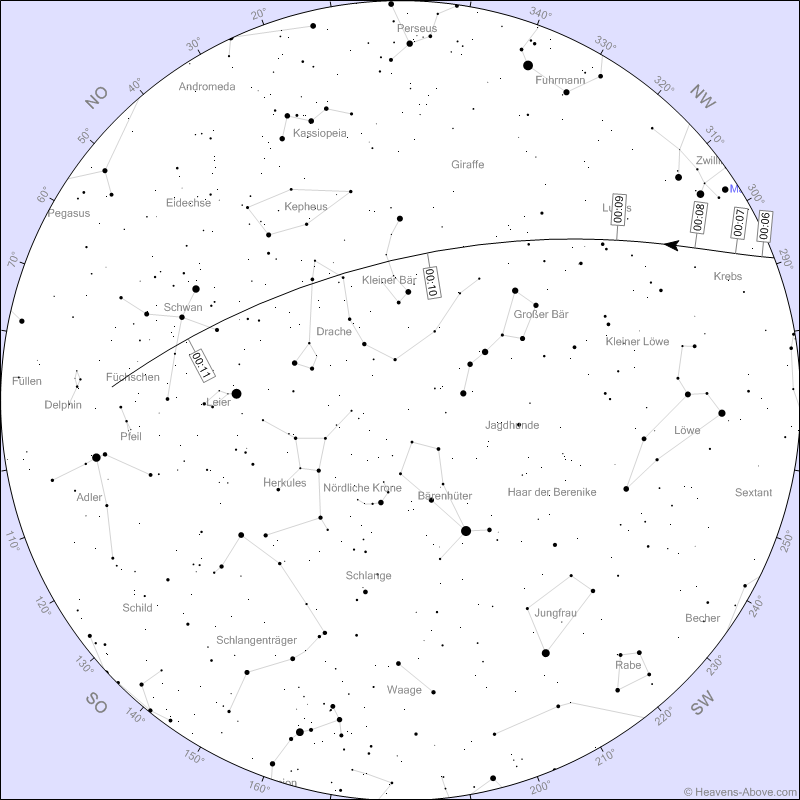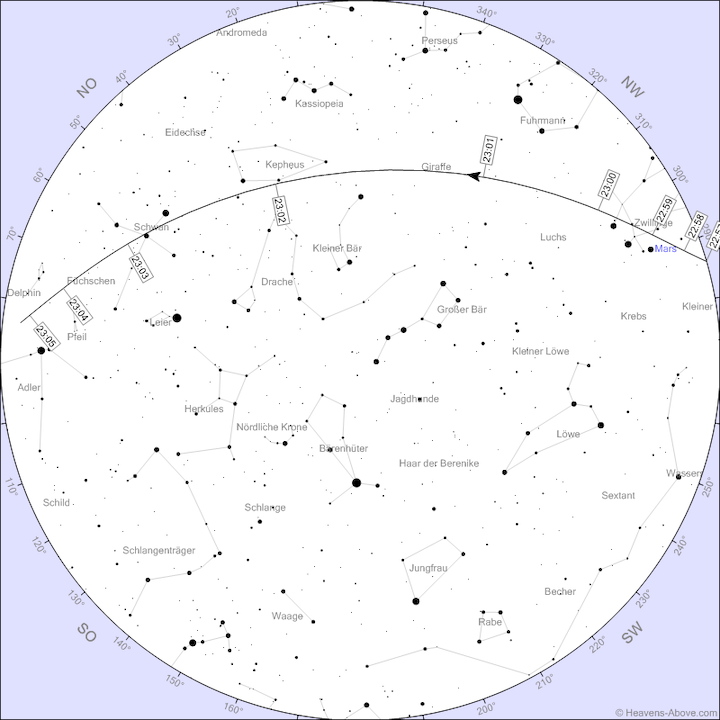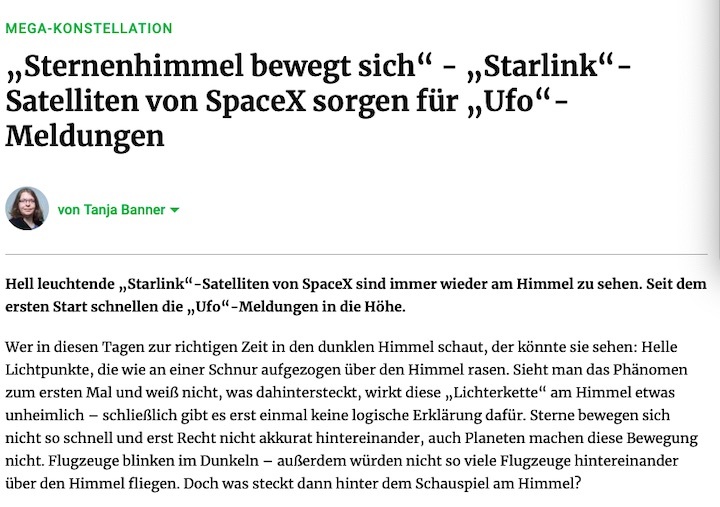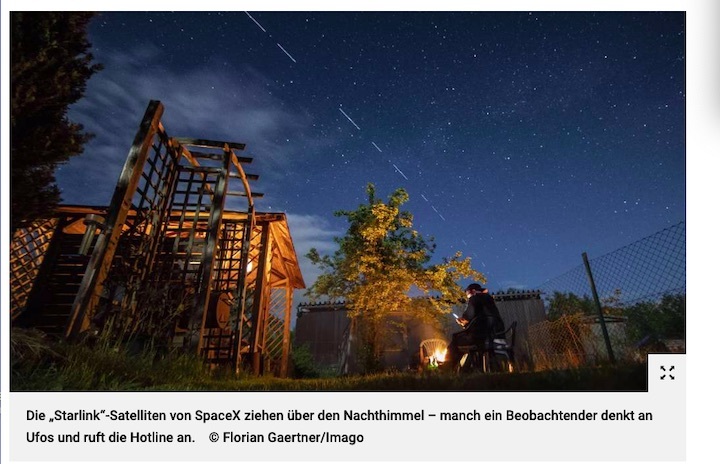24.05.2021

24.05.2021
Auch dieses Wochenende hatten wir nach weiteren einzelnen Starlink-Satelliten Beobachtungen durch die Woche vermehrt Tel-Anrufe und E-Mails bei unserer UFO-Meldestelle. Gerade der Starlink26-Train und in weiterer Folge Starlink27-Train sorgte für Rätselraten und Nachfragen. Auch bekamen wir weitere Handy-Aufnahmen von den Starlink-Überflügen.
Meldungen gingen ein aus:
Augsburg, Mittenwald, Groß-Gerau, Ludwigsburg, Mühlheim, Braunfels, Würzburg, Kempten, Hanau, Dieburg, Kühlheim, Wald-Michelbach, Schwäbisch-Hall, Rehfelde/Brandenburg,
Stand: 24.05.2021 / 17.00 MESZ
CENAP
+++
Handy-Fotos von Starlink-Beobachtungen am Wocheende und als Referenz-Aufnahmen dem CENAP-Archiv zur Verfügung gestellt:

+++

+++

+++

+++


Neben den Starlink27-Train über Schwäbisch-Hall sorgte dann der ruhende Stern neben dem Mond zusätzlich zur Verwunderung bei nach dem der Starlink-Train in der Nähe des Mondes vorbei gekommen war. Doch auch dieses Rätsel konnte gelöst werden, da es sich hierbei um Spica handelte welche der Beobachter mit seinem Handy ebenfalls fotografierte.
CENAP
+++
Blick auf die Schlagzeilen der Starlink-Überflüge:
.
What Is That?! SpaceX’s Starlink Satellites Explained

Starlink is the name of a satellite network that SpaceX is developing to provide global broadband coverage for high-speed internet access, particularly for people across the world in rural and remote areas. SpaceX has launched more than 600 new Starlinks this year, typically launching 60 at a time. As of last week, that places the number of Starlink satellites currently in orbit at more than 1,500. Over the coming few years, SpaceX plans to send up at least 12,000 Starlink satellites. Satellite internet is beamed through space at a rate that’s reportedly 47% faster than fiber-optic cable internet. All well and good. But the Starlinks are bright. They can be seen in the night sky. Each launch creates what’s being called megaconstellations – groups of satellites moving together. Is 2021’s sudden upsurge in the number of Starlink satellites also causing UFO sightings to increase? Plus, astronomers are worried. The Starlink satellites are photobombing astronomical images. They have the potential to interfere with the professional observations that have brought us our modern-day view of the cosmos.
The proposal for Starlink was announced by SpaceX CEO Elon Musk back in January 2015. Though it wasn’t given a name at the time, Musk said that the company had already filed documents with international regulators to place about 4,000 satellites in low-Earth orbit. He said in a speech when revealing the project:
We’re really talking about something that is, in the long term, like rebuilding the internet in space.
And his predictions so far have proven true. Musk’s initial estimate of the number of satellites quickly grew, as he hoped to capture a part of the estimated $1 trillion worldwide internet connectivity market. The U.S. Federal Communications Commission (FCC) has granted SpaceX permission to fly 12,000 satellites, and perhaps as many as 30,000 eventually. To put things into perspective: only about 2,000 operational satellites currently orbit Earth. Fewer than 9,000 have ever been launched in all of history, according to the United Nations Office for Outer Space Affairs. Starlink satellites orbit at an altitude of 340 miles (550 km). At that height, they’re low enough to get pulled down to Earth by atmospheric drag and burn up in a few years, so that they don’t become space junk once they die (a problem SpaceX may hope to tackle using Starship). Each one weighs 500 pounds (227 kg), and measures about the size of a typical coffee table, according to Skyandtelescope.com.
It was exciting to see the first few Starlink satellites, traveling together in the night sky. But then more were launched, and then more. And astronomers began to worry.

View at EarthSky Community Photos. | Vince Tuboly in Hegyhátsál, Hungary, caught these traveling Starlink satellites on May 9, 2021 and captioned it: “New series Starlink satellites.”
SpaceX’s two test satellites, TinTinA and TinTinB, launched in 2018. The mission went smoothly. Using that initial data, the company decided it wanted its fleet to operate lower than originally planned. Regulators deliberated and the FCC approved the move.
The first 60 Starlink satellites were successfully launched on May 23, 2019, aboard a SpaceX Falcon 9 rocket. Members of the Starlink team plan to launch up to 60 more per Falcon 9 flight, with launches as often as every two weeks in 2021. Of the 15 Falcon 9 launches so far this year, all have been dedicated to lofting 60 Starlink satellites apart from two, bringing the total number launched so far this year to 722 as of today. One – the Transporter-1 rideshare mission in January – carried only 10 satellites, and the other – the Capella Space rideshare mission launched last Saturday – carried 52.
Starlink controversy within the astronomy community. Despite the promise of high-speed broadband internet, SpaceX has taken criticism within the astronomical community for its Starlink satellites, due to their brightness and potential to disrupt observations of the night sky. The National Science Foundation and the American Astronomical Society released a report on the situation in August 2020. Discussions among more than 250 experts at the virtual Satellite Constellations 1 (SATCON1) workshop expressed concern that the bright train of satellites marching across the sky will hinder their observations.
In response, SpaceX has begun outfitting their satellites with a blackened sunshade – called VisorSat – that the company hopes will reduce the satellite’s apparent brightness by reducing the amount of sunlight that’s reflected. This is just one of the six suggestions proposed by the SATCON1 team. Initial efforts at mitigating the spacecraft’s impact involved launching a prototype Starlink satellite later dubbed DarkSat earlier this year, which features a black antireflective coating. Recent ground-based observations of DarkSat in orbit found it half as bright as a standard Starlink satellite, which is a good improvement, according to experts, but still far from what astronomers say is needed. Jeremy Tregloan-Reed, a University of Antofagasta astronomer on the observational team that assessed the prototype, commented:
I would not consider DarkSat as a victory but instead a good step in the right direction.
The team compared DarkSat with a typical Starlink sibling using a two-foot (0.6-m) telescope at the Ckoirama Observatory in Chile and found that although DarkSat’s antireflective coating rendered it invisible to the unaided eye, it remains far too bright to avoid interfering with the Vera C. Rubin Observatory – now under construction in Chile – and other major telescopes. Additionally, DarkSat’s darker color retains too much heat, so the company is sticking with the visor alternative instead.
Astronomers are hoping to observe VisorSat and compare it with DarkSat once observatories reopen following the Covid-19 shutdown. With SpaceX’s plans, plus Amazon’s Kuiper project, OneWeb, China’s Hongyan, and other projects launching their own global networks of hundreds or thousands of satellites with little to no regulation, the scale of astronomy’s satellite-constellation problem might only increase.

Bottom line: Have you seen a group of bright satellites crossing the night sky together? They are likely SpaceX Starlink satellites, which create relatively bright, large, moving megaconstellations. Starlink’s goal is to provide global broadband coverage for high-speed internet access, especially for rural and remote areas. Astronomers and skywatchers worry about Starlink’s potential to interfere with their work understanding the universe, and their enjoyment of the night sky.
Quelle: EarthSky
----
Update: 26.05.2021
.

Quelle: Twitter
+++






Quelle: RTL Hessen, dpa
----
Update: 28.05.2021

28.05.2021
Da das UFO-Thema momentan die Schlagzeilen um die Pentagon Veröffentlichung im Juni beherrscht und sicherlich bald lange Gesichter geben wird bei der UFO-Gemeinde, da es sicherlich nicht die Antworten erhält die sie gerne hören möchten. Kümmern wir uns jetzt um die Beobachtungen welche hier bei unserer UFO-Meldestelle eingehen. Wiederholt gab es Meldungen welche wir auf normalen Flugverkehr zurückführen konnten, aber nach wie vor kommen Beobachtungen welche durch Starlink-Überflüge verursacht wurden.
Meldungen kamen aus:
Berlin-Süd, Gießen, Worms, Mannheim-Feudenheim, Freiburg, Weschnitz, Fulda,
Stand: 28.05.2021 / 9.00 MESZ
CENAP
+++
Blick in die internatiuonale Presse:
No, that wasn't a UFO flying over Montreal

MONTREAL -- Montrealers looking up into the sky Wednesday night might have seen something unusual.
Was it a bird? Was it a plane? No, but some Montrealers thought it could have been a UFO.
"I was outside enjoying the cool air and waiting to get a picture of the full moon when this came across the sky," said Leslie Arsenault. "I didn't realize this is not normal."
The lights were seen across different parts of the Greater Montreal Area.
"I didn’t know what to do with it, so I did some research and found out that this same flying object was seen in Colombia and Chile at the beginning of May," said Mehak Sakhrani, who saw the lights at 9:30 p.m. in Brossard on the South Shore. "I’m sending this to you in hopes of reaching out to anyone else who saw it. It’s truly unexplainable."
Bryan Gosman saw the lights flying overhead in the West Island.
"I came out and saw that there were helicopters and what looked like jets," he said. "This was crazy."
There is an explanation for the strange sightings; one that's a little less extraterrestrial.
Experts say the bright lights are from Starlink satellites, launched into space by Elon Musk's company SpaceX.
It's a satellite internet service that promises high speeds and low latency without requiring broadband infrastructures.
The satellites have been nicknamed "mega-constellations" for the way they move, orbiting low to the Earth, in the same scope as the International Space Station.
Experts explain the reason the low-flying satellites are so easily visible to the naked eye is because they reflect sunlight.
SpaceX says it has tried to reduce the reflectivity of its satellites after complaints from astronomers by adding an anti-reflective coating to its newer satellites.
Quelle: CTV News
----
Update: 29.05.2021

29.05.2021
Wieder bekamen wir in vergangener Nacht Beobachtungen von Starlink-Satelliten bei unserer UFO-Meldestelle. Starlink27-Train war gegen 23.45MESZ über den Bereichen wo Wolkenlücken waren gut zu sehen.
Meldungen kamen aus:
Tübingen, Zell am See, München-Nord, Nieder-Aula, Ludwigshafen/Rhein.
Stand: 29.05.2021 / 9.30MESZ

Starlink27-Train Überflugkarte, Heavens Above
CENAP
+++
Über Glasgow wurden sie auch gesehen:

Quelle: Daily Record
+++


Quelle: rnf
----
Update: 30.05.2021

30.05.2021
Heutenacht gegen 0.07 MESZ überflog Starlink-27 Train den Himmel und wurde von mehreren Rauchern beobachtet, alle sagten und schrieben das sie zum Rauchen auf den Balkon bzw. auf die Terrasse gegangen sind und dann diese hintereinander fliegenden Lichtpunkte, Flugzeuglichter ohne Ende aber ohne Geräusch, viele Satellitenähnliche Objekte gesehen hätten.
Meldungen kamen aus: Bruchsal, Reutlingen, Pforzheim, Kitzingen, Straubing, Hardheim, Grasellenbach,
Stand: 30.05.2021 / 13.15 MESZ
+++
Überflugkarte von heute gegen 0.07 MESZ von Starlink27 Train

Quelle: Heavens Above
CENAP
----
Update: 31.05.2021

31.05.2021
Auch in der Nacht von Sonntag auf Montag konnte der Starlink27-Train beobachtet werden und führte zu Meldungen bei unserer UFO-Meldestelle.
Beobachtungen kamen aus: Delbrück, Schöffengrund, Riedstadt, Kupferzell,
Stand: 31.05.2021 / 17.00 MESZ
Blick auf Überflug-Karte von Starlink27-Train:

Quelle: Heavens Above
+++



Quelle: ntv
----
Update: 9.06.2021

9.06.2021
Im Laufe der letzten Tage bekamen wir bei unserer UFO-Meldestelle weitere Beobachtungen welche durch die Starlink27 Satelliten ausgelöst wurden.
Meldungen kamen aus:
Bremen, Immenstadt, Neustadt, Hanau, Bornheim,
Stand: 9.06.2021 / 21.00 MESZ
+++
Einen neuen Starlink-Satelliten-Effekt ist am 2.Juni 2021 über Bornheim durch ein Flare von ausgefallenen Satelliten auf Meteor-Kamera aufgezeichnet worden.

Flare I'd wager about -6 apparent magnitude.
Foto: Locastan, Bornheim
+++


Quelle: Twitter
+++









Quelle: Frankfurter Rundschau
----
Update: 12.06.2021
.








Quelle: Frankfurter Rundschau
----
Update: 14.06.2021
.
SpaceX satellites soaring across the night sky have many wondering what they are
If you have looked up at the night sky lately, you may have seen a string of lights blazing by.
While these may be an unidentified object to a lot of people, they are part of Elon Musk’s goal of universal internet.
These SpaceX satellites, known as Starlinks, are often as bright as an airplane and travel in packs of up to 60 satellites. They orbit the earth at one of the lowest elevations allowed for spacecraft, around 186 miles above earth's surface and up to almost 342 miles high.
Currently, there are about 1,800 Starlink satellites in orbit. SpaceX has applied to place upwards of 30,000 satellites in orbit to provide high-speed wireless internet.
For scale, currently there are about 4,300 active satellites orbiting the planet and historically, only 11,670 ever placed into orbit since the launch of the first satellite, Sputnik, in 1957. According to SpaceNews.com, SpaceX began placing Starlink satellites in orbit in May of 2019.
When we reached out to SpaceX for more information they said no one was available for an interview.
“Starlink is just one representative of a whole new class of what are being called satellite mega-constellations,” said Dr. John Barentine, the director of conservation of the International Dark-Sky Association. These mega-constellations are a group of satellites that fly together in some sort of formation.
While Global Positioning Systems rely on the same idea of satellite formations, there are only a few dozen of these satellites, whereas SpaceX plans to launch thousands and possibly tens of thousands over the next ten years. Barentine said there are other companies both here in the United States and globally that want to build satellite mega-constellation systems aimed at providing high-speed wireless internet, including Amazon.
“By the end of this decade there could be on the order of 100,000 functional satellites in orbit around the earth and that is more than a ten times increase in what there is now,” said Barentine.
‘Loss of opportunity’
Many astronomers and astrophotographers have expressed concern over the impact these satellites have on the darkness of the night sky.
Barentine, who holds a Ph.D. in astronomy, explained many astronomers are concerned about the potential loss of scientific data due to interference with photography equipment. He explained equipment used to photograph sensitive astronomical features–such as gamma-ray bursts, which only last a few seconds–could be impacted by light from a Starlink satellite.
Many things astronomers try to document and study happen so infrequently with a lot of planning. Any small dot of light traveling across the camera's sensor could obliterate what researchers are trying to see. With more and more satellites projected to orbit the earth, there will be fewer opportunities to study rare astronomical events.
Another effect, recently established in a paper published in April and co-authored by Barentine, looked at the overall impact of the light from the Starlink satellites. These satellites increase the overall brightness of the night sky by shining light, which otherwise would just pass by earth, down towards the surface, adding up to a “diffused glow across the sky,” Baretine said.
“I thought it was breathtaking to see, but once it soaks in, it is kind of a little bit heartbreaking,” said Kurt Kuznicki, the associate director of Friends of Nevada Wilderness and a local landscape photographer. Kuznicki has long been making images of the night sky and what he calls the “ancient light.”
He is concerned these satellites will take away from the wildness of the dark skies. While Nevada and the American west are filled with wide-open spaces and public lands, Kuznicki said it is hard to find an area without jet traffic and “even harder to find quality dark skies.”
‘We are fundamentally in a different era’
Barentine has noticed an increase in satellites in the last couple of years. Whenever he takes out his telescope, he said he can find a moving object in nearly every field of view after just a few minutes.
He explained that SpaceX has taken measures to mitigate this new form of light pollution. Efforts have been put in place by SpaceX, according to Barentine, to reduce the light pollution the satellites emit. He said they have begun to darken the surfaces of the equipment and install sunshades. He also said SpaceX engineers have directed the satellites to make a complex rolling maneuver to adjust the alignment of the satellites in relation to the sun and the surface of the earth; the goal being to reflect less light back to the surface of the earth.
Kuznicki plans to do his research and learn when the satellites are out and work around them when making dark sky photography. While there are several applications photographers and stargazers can use to plan their stargazing and photography, Stellarium is a free program available for most browsers and is a great tool in virtually touring the night sky.
As warmer summer nights approach, stargazing is a perfect excuse to get outside. Planning a night of stargazing can lead to great success.This website predicts when a Starlink mega-constellation will cruise by any given location.
For more information on the International Dark-Sky Association, visit http://www.darksky.org.
Quelle: renp gazette journal
+++

14.06.2021
Die letzten Tage bekamen wir weitere Meldungen welche wir auf Starlink-Überflüge zurückführen konnten.
Beobachtungen kamen aus: Hameln, Bad Dürrenberg, Plauen, Freihung,
Stand: 14.06.2021 / 7.00 MESZ
CENAP
+++
